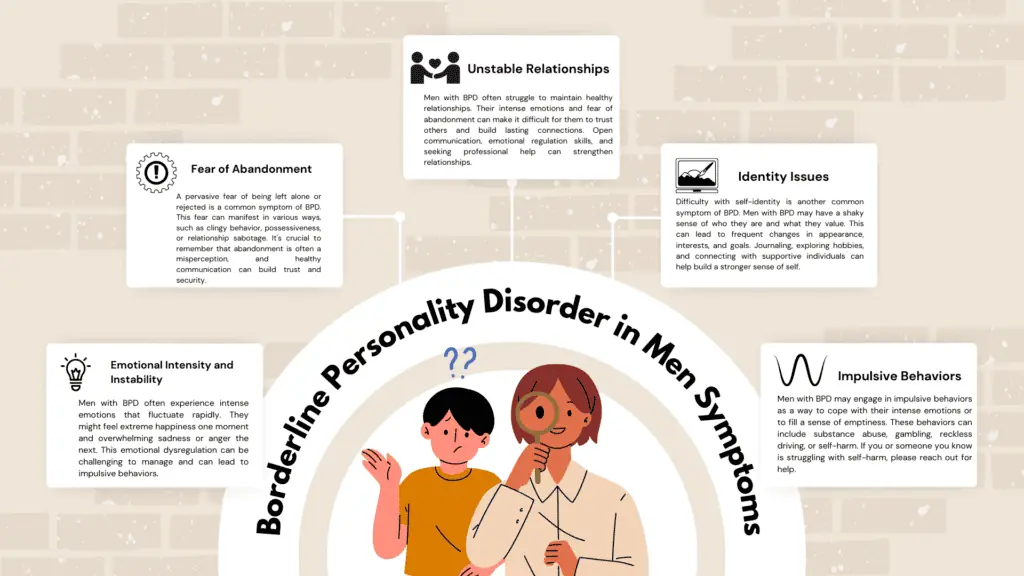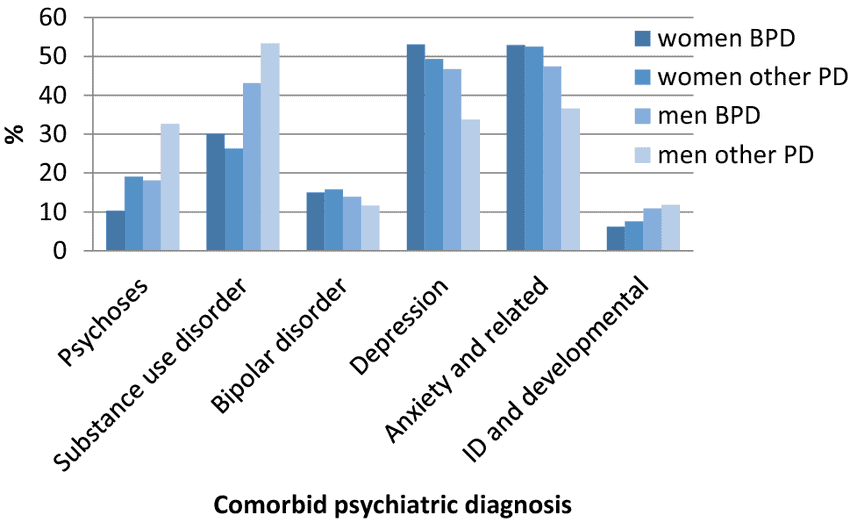Borderline personality disorder (BPD) is a mental health condition that leads to problems with emotions and relationships. While there are general characteristics associated with BPD, the condition may look different in men vs. women. In my experience, men with BPD can appear hostile and confrontational, when in reality they are coping with deep emotional pain. Below, learn about common BPD symptoms, as well as how they can look a little bit different in men.
Common Symptoms and Behaviors
As a personality disorder, BPD is a pattern of thinking and behaving. A person diagnosed with BPD has a pattern of thoughts and behaviors that differ significantly from what is expected. These differences cause significant distress, as well as difficulties with functioning in life.

Some common features of BPD include:
- Viewing the world in black-and-white extremes, as either good or bad
- Frequently changing interests and opinions
- Intense, unstable relationships
- Quickly changing one’s opinion of other people
- Extreme fear of being abandoned
- Difficulty being alone
- A chronic feeling of emptiness
- Repeated experiences of mental health crisis, which can include self-harm
- Intense outbursts of anger
- Difficulty regulating emotions
- Engaging in risky behavior, such as gambling, unsafe sex, or excessive spending
- Unstable sense of identity
Challenges in Diagnosing BPD in Men
BPD is diagnosed using criteria in the Diagnostic and Statistical Manual of Mental Disorders. This diagnostic manual requires a person to show five or more symptoms of BPD to be diagnosed with a mental health condition.
While the diagnostic criteria are the same for men and women, men can be more challenging than women to diagnose, because symptoms can appear differently in men. Historically, it was believed that women were more likely than men to have BPD. However, more recent data show that there is no difference in prevalence between men and women.

Variation in BPD prevalence based on gender may be a result of different presentations between men and women. For example, men with borderline personality disorder tend to seek novelty and demonstrate explosive anger. Men with BPD are also more likely to show signs of substance abuse and antisocial personality disorder.
On the other hand, women with BPD are more likely to experience eating disorders, mood disorders, anxiety, and post-traumatic stress disorder. Some research has shown that women tend to demonstrate more severe BPD symptomatology, whereas men with BPD tend to be more narcissistic.
So, in summary, men with BPD are more likely to present with antisocial and narcissistic personality features. They’re also more likely to be emotionally explosive, but they demonstrate fewer BPD symptoms than women. From what I have seen, people may not realize that a man with BPD is struggling with a mental health disorder. Instead of recognizing the underlying trauma in men with this condition, people are likely to see only anger and explosiveness. They may think the man is just rude and hot-tempered.
This suggests that BPD may go unrecognized in men, because they may be dismissed as having an anger or substance abuse problem, or they may be seen as antisocial or narcissistic. Men with BPD may be written off as simply being angry or difficult when in reality, they are living with symptoms of a diagnosable mental health disorder.
Professionally, I have seen men who have gone undiagnosed, because they were mistakenly labeled as just being angry or deviant. I believe it is best practice to assess for BPD in men who present as angry or aggressive.
Treatment Approaches for BPD in Men
Research has shown that men with BPD are less likely than women to receive therapy and psychiatric medication, but this does not mean that men with BPD don’t need treatment. Instead, it is important for therapists and other mental health professionals to ensure that men with BPD are identified and connected to appropriate interventions. You can also consider using online therapy, and for that, we recommend BetterHelp, where you can find a therapist who specializes in helping men manage emotional dysregulation and build healthy relationships
Dialectical behavior therapy (DBT) is an established treatment for BPD. This modality uses approaches from mindfulness to help people attend to the present moment and become less emotionally reactive. It also teaches interpersonal and emotion regulation skills. DBT has been identified as effective for men with BPD; this modality reduces BPD symptoms and aggressive behavior.
Other therapeutic approaches for BPD include mentalizing-based therapy (MBT), which helps people with BPD to stop making assumptions about others’ behavior, and transference-focused psychotherapy, which uses the relationship between patient and therapist to help the patient identify dysfunctional interpersonal patterns.
Some people may take medications to help manage BPD symptoms, but there are no medications approved specifically for treating BPD. Antidepressants, mood stabilizers, and antipsychotics are sometimes used in BPD treatment, but they may not be effective in alleviating symptoms.
Myths about BPD in Men
There are several myths about men with BPD, but it’s important to understand that myths are often problematic. People come to believe these things based on stereotypes or what they’ve been told by others. This can lead to misunderstandings, which can be harmful for people living with BPD.
You might have heard some of the following myths about BPD in men:
- Men cannot be diagnosed with BPD, since it’s a disorder based on difficulty with regulating emotions: You’ve probably heard the stereotype that women are more emotional than men. This is a harmful depiction of gender differences, and it does not reflect reality. The truth is that men can be diagnosed with BPD; they are just more likely to have difficulties with anger and aggression.
- Men with BPD cannot be cured: While there isn’t necessarily a cure for BPD, men with BPD can benefit from treatment. BPD treatments have been found to be helpful for men, and they can even reduce criminal behavior.
- BPD is just an excuse men use for bad behavior: Men with BPD aren’t trying to excuse bad behavior. Remember, BPD is a legitimate mental health diagnosis. Men who have this condition can get better with treatment. Men with BPD have differences in brain structure that can make it difficult for them to manage emotions. This doesn’t mean it’s okay for them to mistreat people, but it’s helpful to understand the root of the problem.
The bottom line is that men can have BPD, and they are deserving of treatment. BPD is a legitimate condition that can make it hard for a person to manage daily life and enjoy healthy relationships. Fortunately, there is treatment available for men with BPD, and they can get better at dealing with their emotions.
If you or someone you love needs treatment for BPD, therapy can help. A therapist can work with a patient with BPD to help them develop healthier coping strategies. Online therapy can be a suitable choice for BPD treatment. This option allows you to connect with a therapist from the privacy and comfort of your home. This can be a great fit for people who have busy schedules or live far from the nearest mental health clinic.





